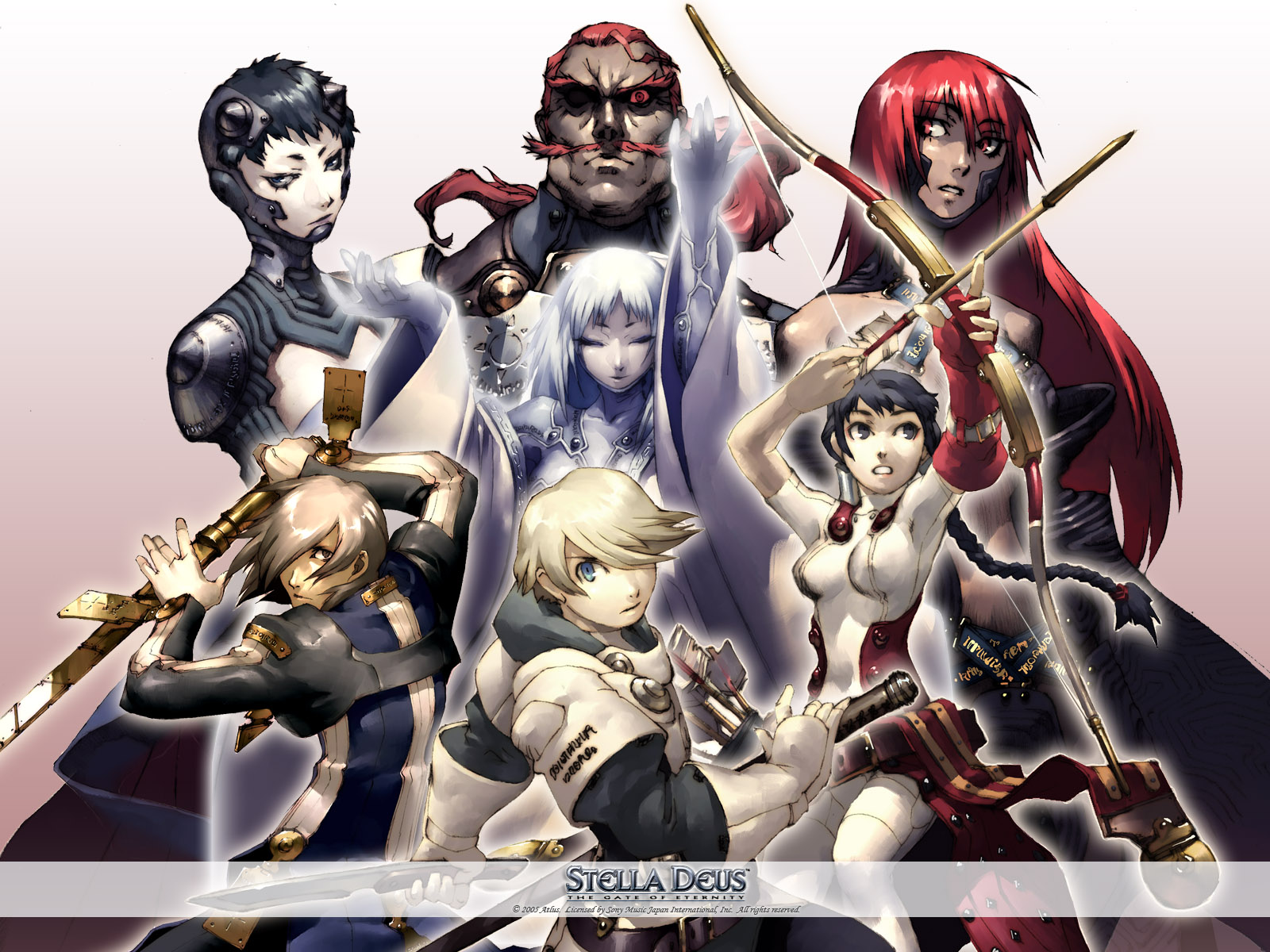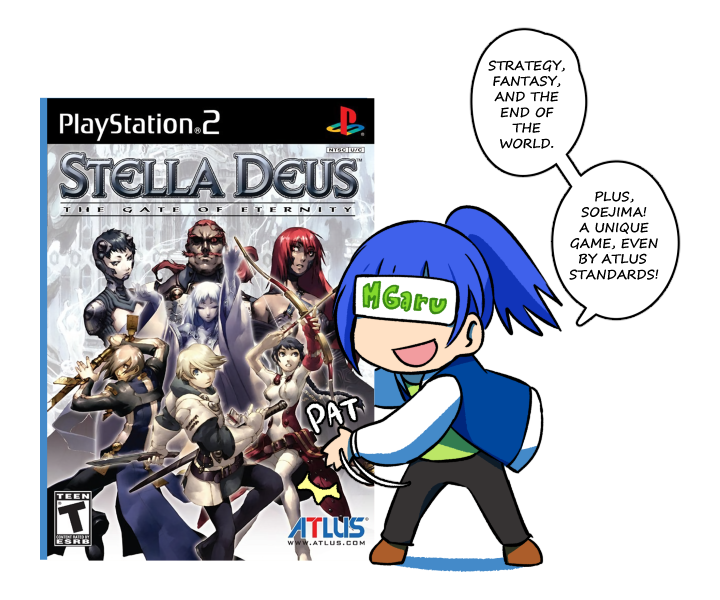“Stella Deus is a highly engaging, isometric strategy game that features complex gameplay [and] an endearing cast of characters that struggle to give meaning to a world that is ending.”










Modern day price range and availability
It will be hard for you to find a cheap copy of Stella Deus for the PS2, so I’d recommend nabbing a digital copy through the PS3’s store for only ten dollars! Remember that the PS3 and Vita stores are going through changes these days, so make yourself familiar with how the store works before heading in.
Stella Deus: Hidden Beauty from Atlus
Stella Deus: The Gate to Eternity is our first PS2 game and, more importantly, it’s our first Atlus game. Passing swiftly by character artist Shigenori Soejima’s characteristic touch (because I can promise I won’t stop talking about it!), little else in Stella Deus will tell you that it is indeed an Atlus game.
That does not mean it is lacking in any department, though; Stella Deus is a highly engaging, isometric strategy game that features complex gameplay with fusion mechanics; an immersive story set in a muted, apocalyptic setting; beautiful orchestral music brought by Valkyria Chronicles’ composer; and an endearing cast of characters that struggle to give meaning to a world that is ending. I proudly count it among my favorite games!
Moral dilemmas encase the story’s core as Spero and his allies face the threat of Miasma, a mist that brings the apocalypse and lays waste to the land. With the world’s end growing near, humans split into groups of conflicting beliefs.

War rages between between Dignus, a conquering warrior seeking ever-greater strength, and Avus, rightful king and leader of the resistance, while another group chooses not to act at all. Pondering the death of humans and the end of the world, the Aeque believe God’s will is a peaceful end. The members of this deeply religious, apathetic group spend their days praying and awaiting their deaths, offering no resistance to violence and refusing to aid any cause.
This group forms the center of the game’s distinctiveness, even when compared to the other titles in Atlus’ eschatological track record. Each time you encounter the Aeque, you witness individuals struggling to reason with dogma.
If God’s will is a peaceful end, why should infants be born? This is but one of the many questions posed by Aeque followers, who Spero and his friends interact with – and often clash with – all throughout the game.
Without a doubt, the standout element in Stella Deus is its gameplay. Battles in Stella Deus are not turn- and phase-based as they are in Fire Emblem, for example. Rather, turn order is decided per each character’s “AP,” which cap at 100 and are necessary for performing any action, from field movements to attacks, combo skills, and even remaining idle. Enemy characters also have AP, and strategy is constantly decided by the player’s ability to ration AP while preventing enemies from using their own AP efficiently.
If that sounds confusing, don’t worry: Stella Deus will ease you into combat, and offers a place to train (called the “Catacombs”) as well as a very, VERY thorough tutorial you can access at any time. Characters have different classes that act differently — for example, Grey can hit two spaces at once — so take your time in the Catacombs to explore everyone’s strengths and weaknesses. Oh, and take care not to hurt an ally that’s in your line of attack!

Stella Deus’ combat is so refined that I could probably go on forever describing the details. Suffice it to say, it is immensely fun to take the time to plan out your offense before starting, and watch your genius swamp the battlefield. It is equally fun to trick enemy troops into exposing their weak points… But I’ll let you figure that out on your own.
I’m going to say something contentious. I like the voice acting in Stella Deus. Sure, it takes an hour or so to get used to, but there are standout voice actors in this game, and I find even the least spectacular voices endearing. For example, Grey and Adara (prominent party members) have great voices, but Spero… I’ll admit that sometimes, he sounds a little flat. But honestly, I love the way he’s voiced. Spero is a kind, open-minded boy, and his voice — which never tips toward extreme anger or sadness — actually compliments his personality very well.
If you’ve played other Atlus games, you’ll hear familiar voices, such as Junpei and Shinjiro from Persona 3, outside of their usual element. If you give it a chance, I’m sure you’ll come to like this game’s voices. If nothing else, recurring characters have the best voice acting, so you won’t have to dread every voiced cutscene, at the very least.
From an artistic point of view, I find Stella Deus to be unique among media with an apocalyptic setting. The colors are so muted, so blanched, in every promotional image, and that was something I adored. The play between blinding whites and dark blues, greys, and browns crafts distinct silhouettes, and all the artwork looks like it was made with soft oil paints, in contrast to the sharp anime style that is often associated with Soejima.
I almost want to compare the setting to Nausicaä of the Valley of the Wind (the film/manga series made by Hayao Miyazaki of Studio Ghibli), although verdant greens are extremely scarce in Solum. There’s a kind of organic-metallic fusion going on everywhere you look, even on the characters’ clothing, that is so enthralling and unusual. Just take a look at the common enemies you fight: most of them look like strange, misshapen monsters covered in an odd metal, their human faces hidden from view.
I must point to Soejima’s original take on apocalyptic fantasy when I give merit to Stella Deus’ exciting visuals. I am a serious admirer of Soejima’s earlier works, though, so I admit to my bias! Thankfully, Project Re:Fantasy looks to inherit the beautiful atmosphere fostered in Stella Deus.
Stella Deus is quite the black sheep of Atlus games. Despite having the familiar touch of Shigenori Soejima’s character design, it can’t really be compared to the Shin Megami Tensei games that were released before and after it. The gameplay is difficult to label under traditional criteria, being something of a mix of turn-based strategy and real-time response from allies and enemies alike. Thematically, Stella Deus breaks away from the dark complexity of Shin Megami Tensei while also distancing itself from the modern joviality in Persona; it’s a fantasy game driven by heroic spirit, shown to us under Atlus’ spotlight, albeit without any dark humor.
As you can see, I could go on and on about my love for Stella Deus! It’s a game that entertains visually, via gameplay (as deep as you’re willing to take it), and with its wonderful, old-school charm.
Truly, Stella Deus embodies the retro ideal; time has only made it shine brighter as a marvelous, underrated classic on the PS2.


